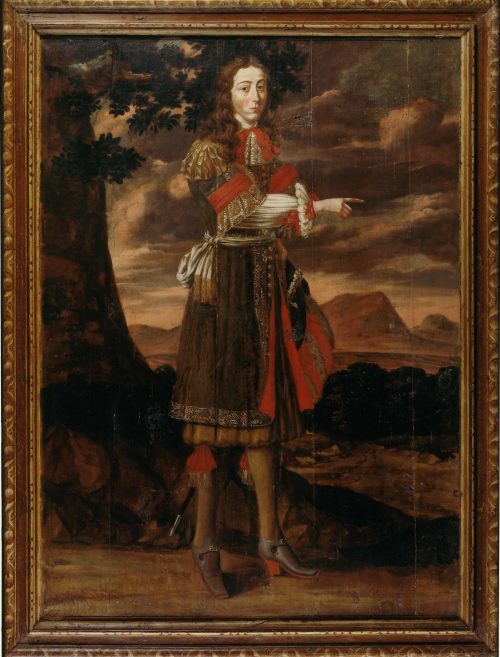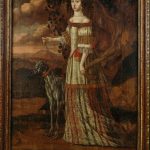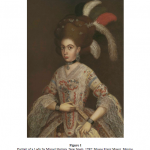9241 A PAIR OF FULL-LENGTH PORTRAITS DEPICTING A NOBLEMAN AND LADY IN A MOUNTAINOUS LANDSCAPE Probably South American. Circa 1700. Measurements: Height: 62 1/4″ (158 cm) Width: 46 3/4″ (118.5 cm) Depth: 2″ (5 cm)

-
Figure 1
Research
Oil on panel. Each with molded frame with painted decoration, depicting a single full-length figure in elaborate formal dress set against a background of a mountainous landscape, the female figure with an attendant dog.
These pendant portraits are superb examples of secular viceregal Latin American portraiture. Latin America developed European-style artistic schools that evolved contemporaneously with their European counterparts, and were “neither an alien cultural phenomenon nor a merely derivative imitation of Spanish art, receiving influences from a broader European, as opposed to narrowly Spanish, spectrum of sources.”1 Artists from various other countries, such as Belgium and Italy, also made their way to the colonies. “The activities of… European artists testify to the extensive establishment of painting in European models… However, the differences among these painters and the heterogeneity of their styles, introduced at various times and places, could not but lead to the creation of distinct local traditions…”2 For example, in the present paintings a point has been made to depict the sitters, not in a lavish European-style interior setting, but in the outdoors among a landscape including mountains, probably belonging to the Andes mountain range.
Portraiture in colonial Latin America was first patronized by the church and the government, but the genre eventually widened to include elite political and social figures as well. “Portraiture served the purposes of the Latin American colonial elites throughout history. It was an ego reward and reaffirmation of status, both personal and familial.”3 The present paintings are marriage portraits of prominent social figures. “During this period, portrait painting was dignified basically by the exemplary nature of the sitter. Consequently, the person portrayed must be adorned with virtues worthy of imitation, while at the same time be depicted as someone of power.”4 Both figures don elaborate costumes and are complemented by allegorical symbols. The male figure wears a sword at his hip; a symbol of temperance, honor and virtue. The female stands in her wedding regalia, as worn by wealthy women of the viceregal era (figure 1), a clear sign of status, and impeccably depicted down to the translucent gauze-like fabric of her veil. She is accompanied by a dog at her side, the symbol of marital fidelity. It is also important to note that the dog in this case is a greyhound. Greyhounds have been seen as symbols of status beginning in the 11th century when the English king Canute “enacted the first laws that restricted the ownership of Greyhounds to the aristocracy”5 and the ownership of such a dog assuredly suggests these were figures of importance, especially as it too is outfitted with a studded jeweled collar.
Footnotes:
1. Benson, Elizabeth P., Miguel Bretos, and Carolyn Carr. Retratos: 2,000 Years of Latin American Portraits. New York: Yale UP, 2004.
2. Rishel, Jospeh J. and Suzanne Stratton-Pruitt. The Arts in Latin America, 1492-1820. New Haven: Yale University Press, 2006. 326.
3. Benson 38.
4. Benson 76.
5. Branigan, Cynthia A. The Reign of the Greyhound. New York: Howell Book House, 2003.



Comments are closed.